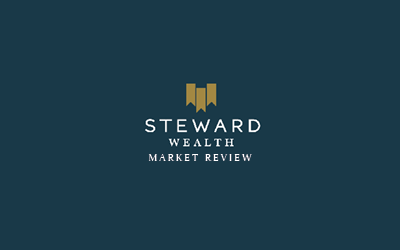Monthly Roundup

For once the month wasn’t all about the central banks, this time commodities and the banking sector were jostling for a bit of the spotlight.
A rude awakening
At one point during September America’s S&P500 index, which, by virtue of having 500 companies in it compared to the Dow’s 30, is far more representative of what’s going on in the broader U.S. economy, had experienced an unprecedented lack of volatility. For more than 40 days the index see-sawed in an amazingly tight band of just over 1%, which saw the volatility index, known as the VIX, trade down to 20 year lows. Market commentators were warning of complacency.
Then, as usual these days, a jolt of reality hit as concern over what the central banks are going to do with interest rates saw the markets fall 2.5% in a day and the VIX jumped more than 50% in a week. Worry took over from complacency, for a while.
The ‘VIX’ volatility index – back to running below long-term averages

Will they, won’t they… they didn’t
The market’s favorite sport of trying to second-guess the U.S. Federal Reserve built to a crescendo with the September meeting of the Federal Open Markets Committee, the group that actually decides where interest rates should be. After much anticipation Governor Janet Yellen announced they had again decided not to raise rates because they want to see more evidence the economy is humming along strongly enough that a rate rise won’t cause it to stall.
With unemployment running at about 5% and wages growth finally showing signs of life, there were certainly some members of the FOMC that felt a rate rise was appropriate. Yellen made it pretty clear the Fed intends to raise rates at the December meeting, which means 2016 could turn out just the same as last year: finish the year with a single 0.25% rate rise having started out the year threatening three or four.
Then it was the bank of Japan’s turn. Having run the most aggressive quantitative easing program over the past five years, the BOJ signaled a change in direction: rather than just flood the market with liquidity they are instead going to target a particular level of bond yields. The negative camp immediately cried that this is proof the central banks are running out of ideas and the efficacy of QE is waning.
The BOJ insisted it’s as determined as ever to boost inflation and prop up growth – they still intend to spend about A$1tn a year buying bonds – but indicated they are simply trying to accommodate the banks and insurance companies that are having a tough time making any money with zero interest rates.
It all sounds a little like we’re still on the wrong side of the looking glass…
Why are interest rates so low?
That has been the subject of an endless stream of reports, blog articles and speeches. Thankfully there’s not enough space here to go into great depth, but suffice to say there’s a very good argument that rates are low right now because of good old fashioned market forces: there’s simply not a lot of demand for bank credit.
Interest rates are effectively the price of borrowing money, and like any product, if demand goes down but supply stays about the same (or even rises) then the price is going to fall.
There’s no shortage of commentators calling low or negative interest rates an ‘artificial environment created by central bank interference’. While that argument is intuitively appealing because we’ve seen central banks do some pretty extraordinary things over the past six or seven years, the fact is there is simply not a lot for demand for credit.
This is shown in the two charts below, the first being U.S. household debt to GDP and the second being private sector credit in the Euro area. Both have flattened right off, meaning the demand for money is low.


And companies aren’t borrowing as much because they’re not spending on new factories at the rate they used to and when they do they can issue bonds at lower rates than most CFO’s would have ever dreamt possible. In fact, during September, two European companies issued bonds at negative yields; that’s right, investors were paying the companies to take their money.
The San Francisco Federal Reserve published a paper arguing the ‘natural rate of interest’, that is the rate where you have optimal use of resources without pushing inflation up, is about 1% in the U.S. at the moment. Until people are ready to borrow heavily again, expect rates to stay low.
Jostling for the spotlight
A few years ago Saudi Arabia thought it would teach those pesky U.S. oil fracking companies a lesson and declared open season on oil production, which sent the price tumbling down (see, another example of markets at work). Instead of going out of business the frackers gritted their teeth, cut costs to the bone and toughed it out waiting for prices to rise, which they eventually did, a little.
Last week OPEC declared the first production cut in years and the markets responded like a scalded cat, with the oil price jumping 10% in a couple of days.
The NYMEX crude oil price

Before we get too excited and rush off to fill up the car before it’s too late, it’s worth remembering OPEC’s record of sticking to production cuts is pretty bad. Also, Iran has said it’s reluctant to cut production and Russia isn’t even in OPEC and, as always, strictly does what suits Russia. Lastly, and by no means least, the higher the oil price goes the more U.S. fracking will come back on line.
The other market focus for the month has been the global financial industry, well mainly the big international banks really, and, well, mainly Deutsche Bank, whose shares have sunk to an all time low.
Deutsche Bank shares – trading at an all time low

Deutsche’s problem stems from a belief that, unlike its U.S. and UK counterparts, it never properly rebuilt its capital position after the GFC. In other words, it doesn’t have enough equity capital to fall back on if something goes badly wrong, in which case it would either have to be bailed out by the German government (which is technically illegal under EU provisions), or it would have to raise capital on the stock market which could only happen at fire sale prices, or it goes to the same place in banking heaven as Lehmann Brothers.
Things haven’t been looking good for Deutsche for a few years and then it started 2016 by announcing its first loss since the GFC. Then last week the U.S. Department of Justice announced it’s seeking a lazy U.S.$14bn in fines form Deutsche relating to shenanigans back in the GFC. That fine is not much less than the bank’s entire market capitalization at the moment. Thus the concern.
Added to that was an announcement by the second largest German bank, Commerzbank, that it is going to sack 20% of its work force in an ongoing effort to rebuild its balance sheet. Not surprisingly there are dark mutterings that the German banking industry is structurally flawed and too fragmented. It doesn’t help that they were overly ambitious and expanded too quickly when times were good and now they face zero interest rates, a lack of credit demand and quieter markets.
The sour taste was made worse by revelations that the darling of the U.S. banking system, Wells Fargo, had been creating unnecessary and in some cases artificial accounts, all in an effort by its employees to hit business targets. Wells Fargo’s shares have dropped 18% this year and the European bank index is down 24%
Australia, 25 years and counting
Australia has clocked up a remarkable 25 years without a recession, having reported GDP growth of 0.5% for the second quarter and 3.3% for the year. But before we pat ourselves on the back too heartily, again the disappointing devil was in the detail. Growth in consumption spending, which is generally seen as the engine of growth in a modern, tertiary economy, halved quarter on quarter to a pretty measly 0.4%. The savior was government consumption spending, which rose 1.9% and government investment spending, which jumped 15.5%. While you’ll always take good news where you can get it, we can’t afford to be too sanguine.
Interestingly, in the post-reporting season wash up September saw a lot of the year’s best performing shares take a bit of a hammering. The so-called bond proxies, stocks that have a strong and steady yield, gave back a bit of the strong performance we’ve seen over the last few years. For example, Transurban, which has tripled in the last five years, dropped 13% from its peak.
Transurban – giving a bit back
Telstra dropped 11%, property trusts also fell, for example Shopping Centre Group was down 12%, and Sydney Airports, which has risen four-fold in the last five years, also slumped 13%. Over the same period, the resources stocks, which for ages couldn’t find a buyer, have become flavor of the month, with BHP rising 13% over the month and RIO 10%.






